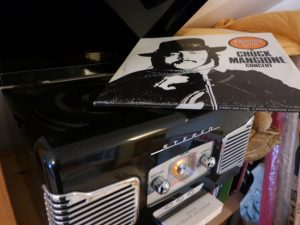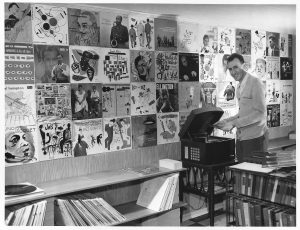
It happens about 15 minutes and 30 seconds in. It’s happens after the flugelhorn introduction from the leader of the band, Chuck Mangione. It follows the entry of the full Rochester Philharmonic Orchestra and the spontaneous applause. Just about the time soprano sax player Gerry Niewood comes in. Right in there, kind of unexpectedly, there’s this short stutter in the recording. No, not in the recording, but in my pressed version of it.
“It’s a locked groove,” I once explained to my daughters, “an imperfection in the pressing of the vinyl disc.”
I can’t remember for sure, but I think one of our girls said, “So why didn’t you get it replaced?”
As I look back on it now, I probably should have gone back to the Sam the Record Man store and asked for a replacement. But maybe because, at the time, I didn’t mind getting up from wherever I was listening to the disc, walking over to my record player, gently picking up the stylus (the record player needle) and putting it back down past the bad groove, the idea of a replacement wasn’t a consideration. I just loved the sound of the recording, “Friends & Love… A Chuck Mangione Concert,” a live recording from May of 1970. It’s always been and probably will always be my favourite vinyl LP (long play) disc. I’m playing now as I write this.
 As old-fashioned as my approach to listening to music may sound, I gather it’s not out-of-step anymore. This week, I read that Sunrise Records, based in Ontario, has just picked up the leases for about 70 former HMV retail stores across the country; reports suggested HMV was losing $100,000 a day in its current configuration. Overnight, the BNN news story says, Sunrise will jump into a leading position selling recorded music in Canada. And while it’s not putting all its eggs in the vinyl basket, Doug Putnam, Sunrise president, says the stores will feature vinyl “front of store.”
As old-fashioned as my approach to listening to music may sound, I gather it’s not out-of-step anymore. This week, I read that Sunrise Records, based in Ontario, has just picked up the leases for about 70 former HMV retail stores across the country; reports suggested HMV was losing $100,000 a day in its current configuration. Overnight, the BNN news story says, Sunrise will jump into a leading position selling recorded music in Canada. And while it’s not putting all its eggs in the vinyl basket, Doug Putnam, Sunrise president, says the stores will feature vinyl “front of store.”
“Vinyl is almost a $1-billion business,” he told BNN, “and it just keeps growing. … We’re seeing everybody from millennials all the way up buying into it.”
Frankly, it’s those in Putnam’s generation (he’s 32) who are explaining why vinyl is enjoying this sudden rebirth. He told CBC Radio this week that vinyl gives younger audiophiles something tangible – a disc, an album cover with art – and sound that’s distinctive with all its clicks, crackles and static. He explained that he grew up with CDs, but with digital music, “there’s not a lot to collect; you’ve got the streaming or digital copy, but vinyl actually allows you to own it!”
When the Napster file sharing and compact discs changed the music industry, we thought forever, I started buying them. And at our house, we’ve gone through several CD players, but whether I play the digital stuff on my iPhone plugged into my car or we enjoy a pile of CDs playing Christmas music each December, back upstairs in my office, I still rely on my clunky old turntable and tone arm to deliver the real music in my life.

And I come by it honestly. My dad was a dyed-in-the-wool audiophile. Both because he covered showbiz for the Globe and Mail and Telegram newspapers and followed jazz artists constantly, he had a sizable LP collection. Indeed, he covered a rec-room wall with LP album covers autographed by such notables as Dizzy Gillespie, Ella Fitzgerald, Stan Getz, Gene Krupa and others. I have a picture I treasure of Dad standing in front of his hi-fidelity record player in front of that wall of fame. The look on his face says it all. “I am right at home here.”
And Sunrise isn’t the only Canadian music retro company on the horizon. Kaneshii Printing has just opened Atlantic Canada’s first vinyl pressing plant. Its owners also see a vinyl revival, so much so that they convinced the Atlantic Canada Opportunities Agency to loan them $175,000 to acquire the old production equipment. Kaneshii can produce 180 records per hour, or more than 1.5 million a year, many of them repressings of old discs.
“There is a big market for the repress market,” Rob Rice told the Guardian newspaper in PEI. “There are a lot of albums out there that have yet to be repressed.”
Vinyl records, as I say, have played an important role in my life. I’ve collected them, played them, traded them; in fact, I came close to selling them. I nearly chose music as a career, not performing it, but searching out new acts to be recorded. Then, at a key moment in that career path, things changed… Oh, but that story will have to wait.
Across the room my Mangione LP just hit that locked grove I told you about, and I’ve got to move the needle past it so I can hear the rest of the concert. A minor inconvenience for the more fulfilling effect of hearing my favourite music from a vinyl disc.